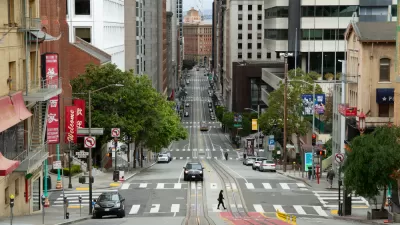The most recent Census data on migration shows the continuation of a decades-long decline in migration in the United States, according to analysis by William H. Frey.

The U.S. Census Bureau released a fresh batch of Current Population Survey Annual Social and Economic Supplement data, bringing the data current to the pandemic's doorstep. William H. Frey provides insight and analysis from the data dump, noting that the continuing trend of declining migration is likely to change in 2020—but there are no Census data to show those changes yet.
Still, newly released pre-pandemic census statistics show a continuation of the decades-long migration decline, bringing the percentage of Americans who changed residence to a post-World War II low of 9.3%. This one-year rate—between March 2019 and March 2020—occurred on the heels of a year when the nation’s total population growth fell to a 100-year low, with a continued downturn in the nation’s foreign-born population gains. Thus, even before the pandemic, the nation was in the throes of stagnating demographic dynamics.
The article provides a history of migration in the United States since the mid-20 century, bringing that history up to date with the Millennial Generation. According to Frey, the nation's largest and most diverse generation ever is stuck in place, relative to previous generations.
Frey concludes the article by providing a bit of insight about what data is available to capture the migration trend of Americans during the pandemic, with the caveat that most information needed to understand pandemic migration is still unknow.
FULL STORY: Just before COVID-19, American migration hit a 73-year low

Maui's Vacation Rental Debate Turns Ugly
Verbal attacks, misinformation campaigns and fistfights plague a high-stakes debate to convert thousands of vacation rentals into long-term housing.

Planetizen Federal Action Tracker
A weekly monitor of how Trump’s orders and actions are impacting planners and planning in America.

In Urban Planning, AI Prompting Could be the New Design Thinking
Creativity has long been key to great urban design. What if we see AI as our new creative partner?

San Francisco Mayor Backtracks on Homelessness Goal
Mayor Dan Lurie ran on a promise to build 1,500 additional shelter beds in the city, complete with supportive services. Now, his office says they are “shifting strategy” to focus on prevention and mental health treatment.

How Trump's HUD Budget Proposal Would Harm Homelessness Response
Experts say the change to the HUD budget would make it more difficult to identify people who are homeless and connect them with services, and to prevent homelessness.

The Vast Potential of the Right-of-Way
One writer argues that the space between two building faces is the most important element of the built environment.
Urban Design for Planners 1: Software Tools
This six-course series explores essential urban design concepts using open source software and equips planners with the tools they need to participate fully in the urban design process.
Planning for Universal Design
Learn the tools for implementing Universal Design in planning regulations.
Gallatin County Department of Planning & Community Development
Heyer Gruel & Associates PA
JM Goldson LLC
Mpact (founded as Rail~Volution)
City of Camden Redevelopment Agency
City of Astoria
Jefferson Parish Government
Camden Redevelopment Agency
City of Claremont





























